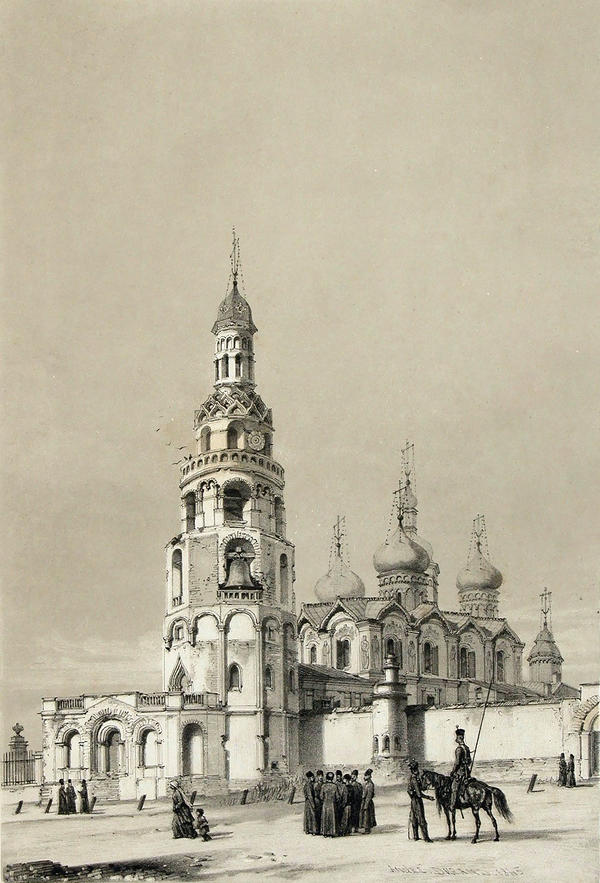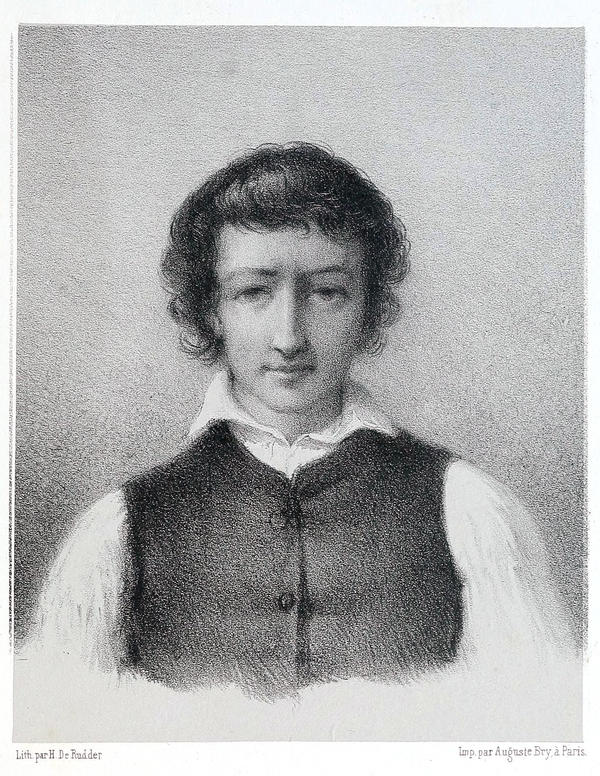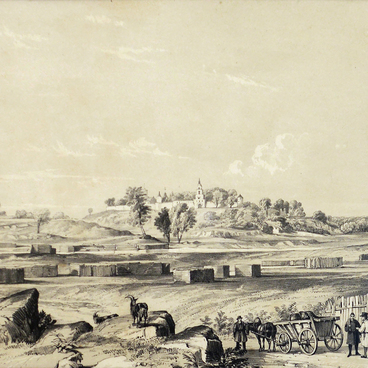The lithograph depicts the Annunciation Cathedral, one of the oldest architectural landmarks in Kazan. Historical records date it back to the period between 1555 and 1562.
Annunciation Cathedral
Время создания
1845 (based on the drawing created in 1839)
Размер
50.3х33.3 cm
Техника
Lithography
Выставка
0
Открыть в приложении#1
Annunciation Cathedral
#10
#11
The cathedral was built by Postnik Yakovlev and Ivan Shiryaev assisted by a team of almost 80 craftsmen on the foundations of the wooden church at the behest of Ivan the Terrible. Limestone from the quarry on the opposite bank of the Volga River was used as a main construction material. The church was built after the Assumption Cathedral in Moscow.
#2
Originally the cathedral had five helmet-shaped domes that were replaced with onion-shaped ones in 1736. In late 16 - early 17 century a winter Nativity Church, a five-tiered belfry, a porch with a staircase and a refectory were added to the cathedral. After being reconstructed several times, the belfry was completely destroyed in 1928. The lithograph made by Andre Durand preserved the image of the lost building.
#12
Andre Durand (1807-1967), the French lithographer, was a corresponding member of the Committee of Historical Monuments. He presented his drawings and lithographs of various archaeological buildings in a prestigious Paris salon. Durand portrayed picturesque buildings and streets in various cities in his works.
#4
In 1839 the artist made a journey across Russia, picturing lots of cities, i.e. Saint Petersburg, Moscow, Nizhny Novgorod, Tver, Vladimir and Yaroslavl. Kazan was the farthest point of the journey where he spent nine days in September. Andre Durand made drawings of a Tatar village, Soyembika Tower, remains of Great Bulgar, the monastery of St. John the Baptist and the Annunciation Cathedral in the Kazan Kremlin. The initiator and sponsor of Durand’s journey was Prince Demidov.
#13
Anatoly Demidov (1812-1870) was a famous charity supporter and diplomat who lived most of his life in Europe but did his most to support Russian science. For example, he arranged and financed an expedition to study rock formations in the southern part of Russia.
#14
Having returned from Russia, Andre Durand started to get his drawings ready for publishing. He himself carried over the drawings to the lithographic stone and put his signature as well as drawing and lithograph printing dates on each sheet. Auguste Raffet (1804-1860) was the one who helped Andre Durand add staffage figures (small human figures) to the composition. Auguste Raffet was a painter and caricaturist, famous for his illustrations to the works of Walter Scott, Chateaubriand and Beranger.
Auguste Raffet. Self-portrait. Lithography. 1870. Source: wikipedia.org
#6
Having returned from Russia, Andre Durand started to get his drawings ready for publishing. He himself carried over the drawings to the lithographic stone and put his signature as well as drawing and lithograph printing dates on each sheet. Auguste Raffet (1804-1860) was the one who helped Andre Durand add staffage figures (small human figures) to the composition. Auguste Raffet was a painter and caricaturist, famous for his illustrations to the works of Walter Scott, Chateaubriand and Beranger.
#9
Their cooperation resulted in the album called Voyage pittoresque et archeologique en Russie which limited edition was published in series from 1842 to 1849. The lithographs demonstrated realistic views of historical heritage sites. Many of the sites did not survive to our days.
#15
National Museum of the Republic of Tatarstan
читать дальшескрыть
00:00
00:00
1x
Annunciation Cathedral
Время создания
1845 (based on the drawing created in 1839)
Размер
50.3х33.3 cm
Техника
Lithography
Выставка
0
Открыть в приложении
Поделиться




